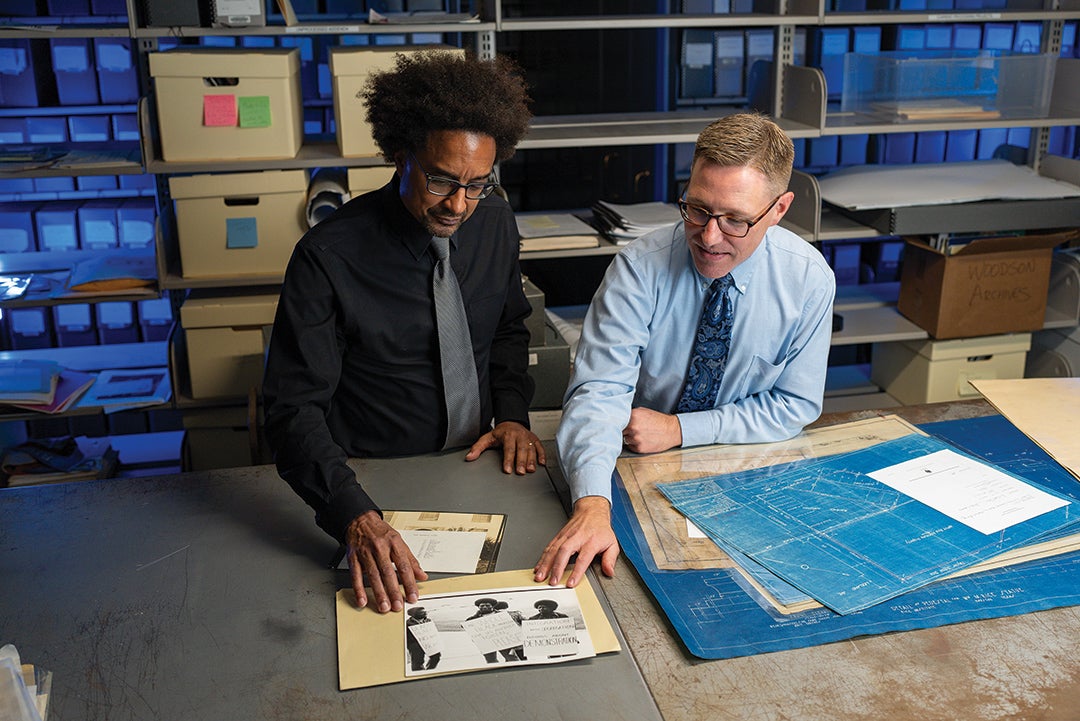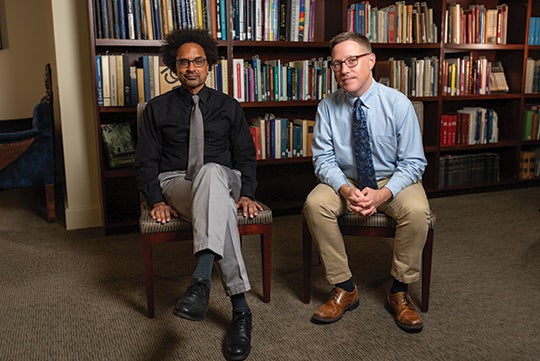Looking Back To Look Forward
Rice historians Byrd and McDaniel discuss their research on Rice's founding and desegregation.

Winter 2024 | By Brandon Martin and Lynn Gosnell
On Oct. 6, 2023, Rice’s Task Force on Slavery, Segregation and Racial Injustice, which was commissioned by former President David W. Leebron in 2019, released its third and final report to the public. The report, titled “Constraints of Race: A History of Rice University and Black Texans from Segregation to Second Founding,” brings to a close a four-year period of in-depth archival research, writing, creative public programming and discussions by dedicated members of the larger Rice community. This final report follows the 2021 publication of two historical narratives, one examining and documenting the entanglement of William Marsh Rice and his business partners in the region’s slave economy, and the other examining the symbolic, ceremonial and popular lore surrounding the Founder’s Memorial, the 1930 statue of William Marsh Rice that formerly sat in the center of the university’s Academic Quadrangle.
To mark the release of the final report, we met up with the task force’s leaders, historians Alexander X. Byrd and Caleb McDaniel, as they reflected on the project they guided for the past four years. Fittingly, our conversation took place in Fondren Library’s Woodson Research Center, where a great deal of the scholarly work took place.
Rice Magazine: What was the initial charge of the task force?
Caleb McDaniel: Back in 2019, the task force was formed and charged by President David Leebron with conducting research about the history of the university with respect to slavery, segregation and racial injustice and also with planning a variety of campus programming that could facilitate discussion about those issues. The final charge was to make recommendations about the future of the university. Four years later, we’ve completed our charge, but certainly, the work that was launched will continue into the future.
RM: What were some of the ways you approached this project?
Alexander Byrd: One of the most engaging ways was a series of weekly [Zoom] meetings that we titled “Doc Talks,” where each of us would bring a [historical] document that we had considered over the previous week and talk about how that document informed the history of the university. It was good for me to get together with my colleagues weekly to talk about the history of the university — what happened to that history when you centered the experiences of African Americans and their contributions to the university. We were also joined by an audience that shaped that work considerably.
CM: A lot of times, the work of history is solitary — sitting in an archive and turning pages. But it’s also very collaborative. Doc Talks brought out the fact that historians test ideas and refine interpretations through that dialogue.
We also had the privilege of working with a steering committee of a couple dozen faculty, staff, students and alumni of the university who brought their own perspectives and experiences and areas of expertise to bear on the work. Over four years, we convened that group close to 30 times, sometimes for daylong conversations or meetings with other guests. Those were the times when I feel like I learned the most about the collective work we were engaged in.
We were grateful to be given the time and space and resources to not just do the original research but to give it time to sit and germinate. That led to some of the most important new insights and discoveries of the research and also, hopefully, will give it more impact in the future.
RM: How did you go about creating such a variety of public engagement programs? And what was their impact?
CM: Over the course of about four years, we hosted a total of 19 featured events — from lectures by distinguished speakers like Annette Gordon Reed or [former Brown University] President Ruth Simmons to panels featuring Black alumni or Black staff, who talked about their experiences at the university. We brought in historians whose institutions have been engaged in similar processes of self-reflection and discovery.
From a conversation we hosted with Raymond Johnson ’69, we learned things about the history of Rice that subsequently informed the narratives we produced. All this was unfolding at a time when many events on campus had to be online. In retrospect, that was an advantage for us, because it meant that we could bring a much bigger audience to those events, including people who weren’t necessarily on campus at the time but had an interest in learning more about what Rice was doing during this moment.
AB: Also, we were able to contextualize the work by bringing historians to campus virtually, those whose life’s work focused on Houston, on Black Houston, for example, which was critically important.

RM: How did you manage expectations for public answers with the need to do such thorough scholarship?
AB: I went into this thinking, naively, that we could be quiet for however many years it took us to finish. We discovered quite quickly that the community had expectations around our work and that those expectations would have to be addressed directly. So, it was more a case of responding and changing direction. The discourse around the Founder’s Memorial that emerged on campus not long after we began the work is one of the clearest examples of the power of history and public curiosity and public activism merging. Those first two research updates are examples of the task force responding to that public interest.
CM: We were so grateful for the expansive charge we were given by President Leebron. A lot of universities had already begun doing research on the history of slavery and the history of American universities — our charge asked us to look at the history of slavery, segregation and racial injustice. It opened up the work to a longer time span and really got to the heart of a key part of American history, which is about the continuities between slavery and segregation and the ways that those histories continue to impact our present.
RM: Tell us more about the final report and recommendations.
CM: We felt from the beginning that it was important to understand the history as well as we could and then to make recommendations that flowed out of that research. This final report is a history of Rice and Black Texans from segregation to what we term the “second founding” — this moment when the university began to transform into the university that we inhabit and appreciate today. It was important to underline that idea of a second founding, that this moment of desegregation was a transformative one that really needs to be understood as the opening of a whole new chapter in our history. Our recommendations come from that understanding.
We began to think about what would improve the university with respect to its students, faculty and staff and its relationship to the city of Houston. What we also were looking at were the recommendations that have the longest history — the things that people have been advocating for a long time.
This final report is a history of Rice and Black Texans from segregation to what we term the ‘second founding’ — this moment when the university began to transform into the university that we inhabit and appreciate today.
A great example of that is the recommendation about hiring Black faculty members — this is a long-standing issue at the university. Another example is the recommendation for a Black Cultural Center on campus. This is something that Black students have been advocating for as long as they have been at the university. We uncovered some of the difficulties they encountered but also some of the successes that they had that maybe aren’t well remembered.
In the early 1970s, there was a building that appeared on campus maps as the Black Student Union Building. Black students had worked hard to impress on administrators at the time the importance of creating space on campus for Black cultural life. But getting the resources and the commitment from the university to sustain that effort was difficult. That building no longer exists on campus maps.
AB: We look back on the first founding of the university as something that has begun and has ended. We can have regrets about it, but there’s nothing we can change about the first founding of the university. That’s not true about this second founding, right? We’re all still very much in this moment. And so how this moment will end and how it will be remembered and its consequences lie with the decisions that we will make moving forward.
Alexander X. Byrd is vice provost for diversity, equity and inclusion and associate professor of history. W. Caleb McDaniel is the Mary Gibbs Jones Professor of Humanities.
Read the task force's final report and recommendations here.
